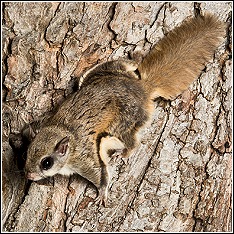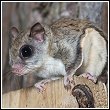Squirrel Facts & Types
Squirrels are abundant around Cape Coral and throughout Southwest Florida. They are a joy to watch and have around, but they can be a nuisance when they work their way inside your attic, fall into your walls, or create a hazard by chewing on your electrical wires or other areas of your home. Understanding their habits is the first step towards co-existing with squirrels. Various types of squirrels have different behavior characteristics so it is good to be familiar with the kinds that might be found around your property.
Habits & Behavior
Like all wildlife, squirrels are mainly looking for three things: food, water and shelter. These three motives are the basis for understanding a squirrel's habits and why they behave the way they do.
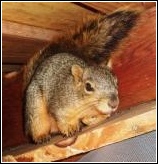
Shelter They Are Looking For
Eating Habits
The average adult squirrel must eat about a pound of food a week to remain healthy. They are omnivores, so they will eat things such as: birdseed, spring bulbs, tree buds, frogs, small birds, eggs, insects, insect larva, fruits, conifer cones, children that throw sticks at them, and nuts.
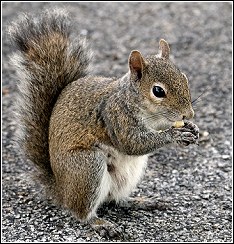
Their food is stored in multiple hiding places, otherwise known as caches. It has been suggested that each squirrel has thousands of caches each season, and the good memory to find them again too.
Territorial Behavior
Squirrels are very territorial. If there is something that kills a squirrel more than anything else it is other squirrels. Females that are currently building a nest, called a drey, are the most aggressive. Do not approach squirrels, they have sharp teeth and cannot differentiate fingers from food!
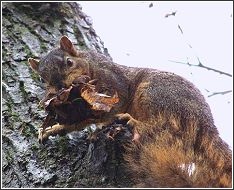
A Tree To Build A Nest
Breeding & Baby Squirrels
Because breeding and gestation periods can vary because of many factors, it is very important that we thoroughly inspect your attic after the squirrels have been excluded from your home. A nest of baby squirrels will not only die, but quickly put your family in a hotel because of the smell of dead squirrels. Typically, a squirrel gestation period is 30 - 44 days.
Below is a photo of a squirrel discovered in an attic by The Wildlife Whisperer taken before and after it went into hiding.
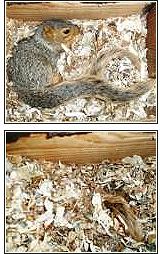
Types Of Squirrels In Southwest Florida
The three types of squirrels found in Cape Coral, Pine Island, Fort Myers, Boca Grande, Sanibel Island, Captiva, and throughout Southwest Florida include the eastern gray (Sciurus carolinensis), fox (Sciurus niger), and southern flying (Glaucomys volans) squirrel.
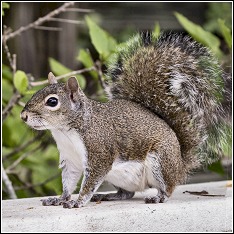
All three of these species can be troublesome and a persistent nuisance when they decide to create havoc for homeowners.
In Southwest Florida, along with the common fox squirrel, there is also a protected fox subspecies with a black head, white feet, and white nose, known as the big cypress fox squirrel (Sciurus niger).
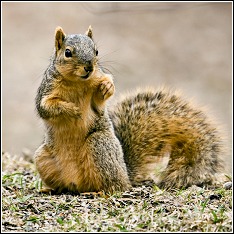
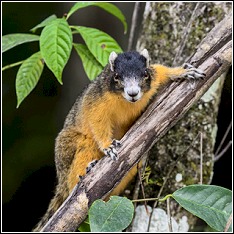
Squirrels in other areas of the state include the Mexican gray (Sciurus aureogaster) found in the Keys, the Eastern Chipmunk (Tamias striatus) found in the northwest corner of the panhandle, and three subspecies of the fox squirrel, including the Sherman's fox squirrel (Sciurus niger shermanii) found in the open piney woods of central and northeastern Florida, and the Bachman's (Sciurus niger bachmani) and southern fox (Sciurus niger niger) squirrels found in the panhandle.
Regardless of the species, you do not want any of them in your house.
The Eastern Gray Squirrel
The eastern gray squirrel (Sciurus carolinensis) is the most common squirrel found in yards and attics around Cape Coral, Boca Grande, Pine Island and other areas in the southwestern part of the state.
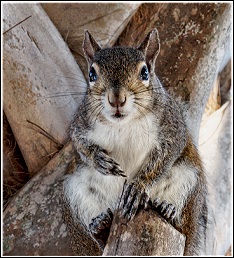
Build Their Nest In Palm Trees
They have a body approximately 18 inches long, including a bushy tail. The grays can vary in color, ranging from a light silver gray to an almost pure white, and sometimes even all black. The white belly and reddish tinge can confuse folks as to its proper species.
On occasion, white colored squirrels are spotted around the state, in most cases these are believed to be an eastern gray squirrel, which carries a gene that in rare cases can make their coat white.
They eastern gray squirrel naturally nests in trees but loves attics most of all, where it is known for its fondness of chewing on electrical wires.
Gray squirrels have a high tolerance to humans and have no problem making their home in urban and residential environments.
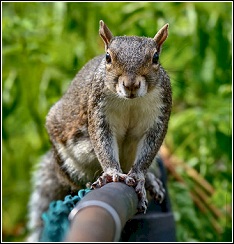
Along A Suburban Florida Fence Top
When alarmed the gray squirrel has a variety of vocal and tail signals that come into play. Research indicates that the combination of these signals, when and how they are used, may be more complex than previously realized. So complex, the idea may be to let other squirrels know specifically what situation is creating the alarm, i.e., a hawk approaching from the air, or a cat approaching from the ground. It is also believed that the signals may have the intention of letting the predator know they've been spotted - in hopes of discouraging the predator away from what it had previously thought would be a surprise attack.
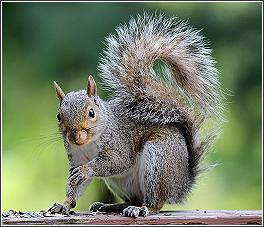
Poised To Sound An Alarm
They eastern gray squirrel tends to be more aggressive than some of the other species in the area, such as the fox squirrel.
In other areas of the country where both gray and red squirrel species exist, the red squirrel is often displaced by the gray species. And in some countries, the gray squirrel is known as an invasive species, because, after being introduced to the environment, it has driven out and threatened the existence of native species in those locations.
Flying Squirrels
Flying squirrels are a common problem in Florida attics, and we frequently receive related calls from residents in Cape Coral, Pine Island, Boca Grande, Fort Myers and Sanibel Captiva.
Many of these residents were surprised to learn there are flying squirrels in their area. Because flying squirrels are nocturnal, they are seldom seen during the day, and it isn't until a homeowner hears one thumping around in their attic that they realize what a nuisance they can be.
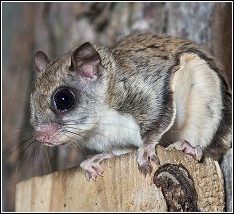
Flying squirrels present an entirely different problem for homeowners than other kinds of squirrels do. Telltale signs include insulation formed into "peaks", scratching sounds, and dragging movement noises, mostly at night around 2 to 4 in the morning. Other signs include feces they may leave behind that will be molasses like in appearance.
The Fox Squirrel
The Fox Squirrel (Sciurus niger) is one of the largest squirrels in Florida, it can grow up to 24 inches long and weigh up to three pounds.
It is believed the fox squirrel got its name because its reddish color, large size, style of movement, and bushy tail make it appear somewhat fox like when it runs along the ground.
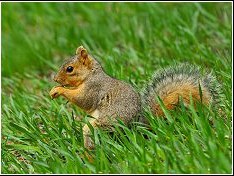
Fox squirrels have babies year round in Florida, and tend to nest in pine, oak and cypress trees, or cabbage palms. In the wild, they utilize natural cavities or notches found in the trees, or expand those started by other wildlife such as woodpeckers. When cavities or not available or not preferred they may build a leaf nest in the tree instead.
The average fox squirrel in Florida tolerates human proximity well, and has learned to thrive in urban and suburban environments, taking advantage of whatever populated areas may have to offer. Keeping that in mind, it is no wonder many of them have chosen the benefits of a warm, cozy attic, over those offered by a natural landscape.
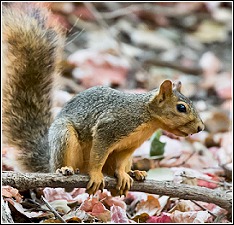
Fox squirrels have strong hind legs and are known for their jumping ability. It is not uncommon for one to be able to jump as much as 15' from tree to tree or tree to roof - something to take into consideration when you are considering squirrel control around your home.
Fox squirrels are quick and not necessarily easy to catch, but faster predators such as bobcats, hawks, owls, foxes and dogs can often get the job done. Nestling and juvenile squirrels are easier prey and often fall victim to raccoons, opossums and snakes. All the more reason for a savvy mother squirrel to seek the protected shelter of an attic.
Compared to the gray squirrel, the fox squirrel is not as territorial.
In spite of living in the trees, fox squirrels spend most their active hours foraging for food on the ground, mainly during the day. Like the eastern gray squirrel, it chatters when alarmed.
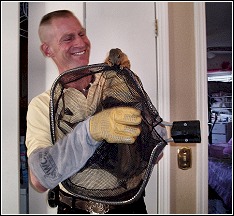
Squirrel From A Client's Home
Fox Squirrel Sub-species In Florida
There are believed to be about four subspecies of the fox squirrel in Florida. The protected big cypress fox squirrel (Sciurus niger avicennia), also known as the mangrove or Everglades fox squirrel, found mostly in Southwest Florida, the Sherman's fox squirrel (Sciurus niger shermanii) found in the open piney woods of central and northeastern Florida, and the Bachman's (Sciurus niger bachmani) and southern fox (Sciurus niger niger) squirrels found in the panhandle.
The big cypress fox squirrel is most common in SW Florida in the western portion of the area and then across eastward along the southern tip.
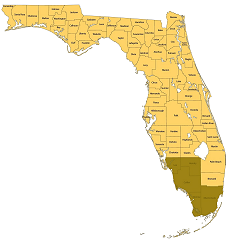
As Indicated By The Florida Fish
and Wildlife Conservation Commission
The big cypress colors are a bit different from that of the common fox squirrel, the big cypress's body is buff or orange in color with a black head, white ears, white nose, white feet and a black or tan tail.

Black Heads With White Ears
The big cypress fox squirrel utilizes the same kind of trees the common fox squirrel does, and it likes to forage along the ground as well, however, it also forages in the trees, and rarely chatters when disturbed.
They tend to be secretive and not commonly seen in populated residential developments. However, they have successfully developed populations within urban areas around golf course habitats. In such cases, their habitat is not endangered, and populations have fared well. In golf course environments, they appear to have become accustomed to human populations and can be seen regularly by those on the course.
The big cypress fox is considered a threatened species and is protected as such. Threats to the species include disease outbreaks and the destruction of habitat due to development, one study cited loss of habitat as the number one threat to the species.
Its adaptation to a golf course environment has helped populations grow a bit in these areas, it is believed that golf courses provide a diverse and stable food source for much of the wildlife that exists there and this may be why the big cypress squirrel is doing so well in those locations.

A Nice Habitat For The Big Cypress
In the future, the golf courses in southwestern Florida may not provide as much protection for the big cypress squirrel population as before.
In the past, the big cypress squirrel was able to move from one course to another when the need arose, allowing golf course developed populations to persist by migrating elsewhere as needed.
The recent concern, however, has to do with courses being cut off from one another by development. As a result, if a current habitat becomes unsuitable, the big cypress squirrel's ability to migrate will be blocked by development, and it will be unable to get to an alternative habitat if needed. Consequently, their chances of survival go down.
1242 SW Pine Island Rd., Suite 310
Cape Coral, Florida 33991-2126
help@totalwildlifecontrol.com



